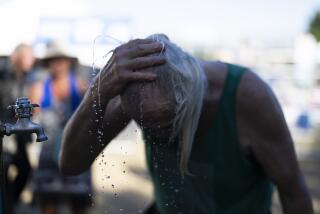U.S. Copters Lead Attack on Iraqis; 500 Prisoners Taken : Gulf War: Skirmishes and a record number of air sorties mark an increasing tempo of action. Officials say traffic accidents are the leading killer of troops.
In the largest roundup of Iraqi prisoners of war to date, American Apache and Kiowa attack helicopters swarmed across the front lines on Wednesday and captured up to 500 enemy soldiers, U.S. commanders said.
Huge Chinook helicopters hauled them to prison camps in Saudi Arabia.
Almost simultaneously, military officials said, an American task force clashed with Iraqi forces south of the Saudi border. The Iraqis called in artillery that killed one American and wounded seven others. But, the officials said, the task force destroyed five Iraqi tanks and 20 artillery pieces and took seven additional prisoners.
The skirmishing plus 2,900 air sorties, the most on any day so far, marked a steadily increasing tempo in the Persian Gulf War as allied forces braced for orders to launch a ground assault into Iraqi-occupied Kuwait.
Pentagon officials in Washington gave some members of Congress detailed briefings on what such a ground assault would employ, including an array of American vehicles and artillery.
In other developments:
* American aircraft bombed a large Iraqi logistics support area containing about 300 vehicles, including tanks. More than 50 of the vehicles were destroyed, American commanders said.
* Crewmen from a British destroyer recovered the remains of Iraqi marines floating in the Persian Gulf and buried them at sea with full military honors. The Iraqis were thought to have been killed by allied attacks on Iraqi patrol boats.
* An Iraqi official challenged Gen. H. Norman Schwarzkopf, commander of U.S. forces in the Gulf, to “try his luck” on the battlefield if he thinks Iraqi forces are nearing a breakdown. The official accused Schwarzkopf of blustering when he told the Los Angeles Times that Iraq’s military is “on the verge of collapse.”
* Officials said traffic accidents on unpaved roads built through northern Saudi Arabia far outpace artillery, missiles and “friendly fire” as the leading killer of U.S. personnel. The hazardous but essential roadways are lifelines that link scattered military camps to each other and to supplies.
The helicopter roundup of Iraqi prisoners was reported by U.S. Marine Brig. Gen. Richard I. Neal, deputy operations director at the Central Command, who said two Apache and two Kiowa attack helicopters swarmed over a warren of at least 12 Iraqi bunkers dug into occupied Kuwait.
The Apaches and Kiowas fired at the bunkers, Neal said.
“I think there were probably some casualties that motivated the surrender,” he said. The Iraqis were stunned, the general said, and between 450 and 500 of them surrendered.
Some details of the attack, as reported by front-line commanders, were still sketchy, he said. He did not say where the attack occurred or identify the American units involved. He said he had no information about the number of Iraqi casualties.
But Neal said the action occurred far enough inside Iraqi-held territory that Chinook transport helicopters were needed to complete the task of moving the prisoners to a holding camp in northern Saudi Arabia.
The desert is littered with similar Iraqi bunkers, said one military official, who declined to be publicly identified. In some, he said, Iraqi vehicles have been damaged or destroyed by allied jets. This meant, he said, that the Iraqi troops were trapped inside without ground transportation.
Any ground assault, the official said, would try to bypass such bunkers altogether.
“If we can bypass them, we will,” he said. “It’s going to be a fast-paced, very rapid method of warfare. We want to roll as quickly as we possibly can.”
In Washington, Rep. William L. Dickinson (R-Ala.), ranking Republican on the House Armed Services Committee, said military officials gave lawmakers a more detailed outline of their plans for overcoming Iraqi ground defenses--including enemy mines, trenches and concertina wire, as well as tank traps.
Iraqi forces have the capability of firing weapons armed with poison gas, Dickinson said. U.S. military leaders expect that, “if they get hard-pressed, the Iraqis will use it,” he said. “But our troops are well-equipped to deal with it.”
The surrender of so many Iraqis at once was accompanied by reports of Iraqi defections, including a trickle from the Republican Guard, considered to be Iraq’s best troops. While the defections were not occurring in vast numbers, one military official said, he noted what he called an apparent decrease in the Iraqi will to fight.
“Once they have taken fire or any kind of aggressive action, they are withdrawing,” said the official, who asked to remain anonymous. “I think I see some timidity here. They are withdrawing so quickly we aren’t seeing a world of fight.”
One official said he had seen reports “that the Republican Guards are defecting and, by their positions, I would infer they are heading north.”
The death of the American, Gen. Neal said, came only minutes before the helicopter assault on the dozen bunkers. It occurred south of the Saudi border during an American-Iraqi clash that triggered Iraqi artillery fire.
The fire hit an American antiaircraft gun and two Bradley Fighting Vehicles. The soldier who died was manning the antiaircraft gun, Neal said. He noted, however, that the action resulted in seven additional Iraqi prisoners captured and the destruction of five Iraqi tanks and 20 artillery pieces.
The dead soldier was not immediately identified.
In still another ground action, Neal said, 10 to 12 Iraqis were spotted in an armored personnel carrier. Neal said allied forces fired a TOW antitank missile at the carrier and destroyed it.
The Air War
In the air, American warplanes bombed an Iraqi armor concentration about 60 miles north of the Saudi-Kuwaiti border Tuesday night, Neal said, destroying 28 tanks, 26 other vehicles, three artillery pieces and three ammunition dumps.
About 300 Iraqi vehicles were spotted in the concentration, which American commanders said was an Iraqi logistics support area.
Additional bombing raids on Wednesday flattened installations on the Kuwaiti island of Failaka, once used as a major Iraqi naval base, according to the Kuwait News Agency.
It said allied planes dropped 50,000 pounds of bombs on the island.
Before the raids, Iraq had shipped all inhabitants to the mainland, the agency quoted informed Kuwaiti sources as saying. They said the bombs destroyed all buildings on the island, including fortified Iraqi positions.
The raids on Failaka were included in the 2,900 air sorties flown by allied forces during the 24 hours ending Wednesday. They brought total allied sorties in the war to more than 86,000.
Military sources in London revealed that half the planes remaining in the Iraqi air force--between 150 and 200 combat aircraft--have been towed to parking places near civilian facilities, which could effectively take them out of action.
These planes will not be targeted by allied warplanes because of their proximity to villages and mosques, said British officials who asked not to be identified. But at the same time, these officials said, it is questionable whether the Iraqis can use them because they are so far from runways and because they are not being maintained.
The British officials gave this tally of Iraqi warplanes:
* About 700 at the start of hostilities.
* About 50 destroyed.
* About 150 flown to Iran, where they are considered to be out of action.
* Between 150 and 200 dispersed away from air bases.
* Between 300 and 350 still in bunkers ready to fly.
In Ankara, Turkey, officials said a U.S. F-16 fighter-bomber crashed because of engine trouble about a mile southwest of the city of Diyarbakir.
They said the pilot ejected and survived.
A U.S. spokesman said the plane had taken off from the U.S.-Turkish base at Incirlik, but he refused to say whether it was headed to or from Iraq. U.S. planes based at Incirlik have been flying bombing missions in Iraq, about 400 miles away.
Before the crash, American planes had flown a reported 3,500 sorties from Incirlik into Iraq without losing a plane or suffering casualties.
In Washington, the Pentagon released the name of another American airman held prisoner by Iraq. He is Air Force Lt. Col. Jeffrey D. Fox, 39. His hometown was not provided.
The Pentagon now lists 17 Americans as killed in the war, 30 missing in action and nine held as prisoners of war.
Burials at Sea
The bodies of the Iraqi marines buried at sea had been spotted floating in the Persian Gulf by crew members of the British repair ship Diligence. They led a boat from the British destroyer Exeter to the scene.
The vessel carried Surgeon Lt. Jonathan Easterbrook and two seamen. They recovered the remains of three Iraqis, bringing to 11 the total number of Iraqi dead taken from the Gulf by Royal Navy units.
Easterbrook, 29, said he cried when he and his men saw the bodies. “These had been young, fit men, probably with wives at home,” he said.
Under terms of the Geneva Conventions, the Exeter team was obligated either to repatriate the bodies or give them local burials.
“It was impossible to recover one of the bodies, so we said a prayer, held a short service and weighted the remains so they sank,” Easterbrook told the Associated Press. The other two bodies were taken to a British supply ship, the Argus, where they were buried at sea with full military honors.
“They were identified as Iraqi marines and almost certainly came off the patrol boats shot up two weeks ago,” Easterbrook said. “Like all distasteful tasks in medicine, you look on it as your job, and you take it objectively. But the thing that we talked about was that they were young lads, possibly with wives and children like ourselves.”
The lieutenant said the task reminded him of a line from the Irish poet William Butler Yeats: “Those that I kill I do not hate, and those that I protect I do not love.”
Said Easterbrook: “Equally, I have no argument with an Iraqi and no friendship with a Kuwaiti.”
Iraqi Challenge
The challenge to Gen. Schwarzkopf came from Iraqi Information Minister Latif Jasim.
Responding to Schwarzkopf’s assessment in a Times interview that the Iraqi army was near collapse, Jasim declared: “Any of the dwarfs of the aggressive alliance who wants to try his luck (in a ground assault) will face a burning fire.”
In a statement carried by the official Iraqi News Agency, Jasim said Iraqi President Saddam Hussein’s army “stands proudly--skilled in combat and with enough faith and sacrifice to deter and crush any criminal aggressor.”
Baghdad Radio said in a commentary that the United States and its allies were “betting on a blitzkrieg” but “backing a loser.” The Iraqi army would turn the land battle into a protracted, high-cost struggle, the commentary said, and send the bodies of allied soldiers home “in endless convoys of coffins.”
The broadcast, monitored in Cairo, quoted an Iraqi war communique as saying “a combat unit supported by helicopter gunships tried to approach our southern lines of defense, but our brave fighters intercepted it and destroyed it after inflicting heavy casualties.” It said Iraqi troops forced “the remaining murderers to flee back to Saudi territory.”
A senior Pentagon official dismissed the Iraqi report as “another figment of the fertile imagination of Baghdad.”
Residents in the Iraqi capital said allied planes raided Baghdad for the second consecutive night Tuesday. Witnesses said billowing flames rose from an undisclosed target, but smog produced by burning oil refineries had begun to lift.
The Iranian news agency IRNA, monitored in Cyprus, said allied planes destroyed a number of Iraqi aircraft at Baghdad’s Al Mothanna airport in Monday night’s raids. “Bits of flying metals from the planes hit nearby streets and motorways,” the agency reported.
Deadly Roads
In all, 135 Americans have been listed as noncombat deaths since U.S. forces began their deployment in the Gulf last August. Of those, 33 have been killed in accidents involving motor vehicles, officials said.
That contrasts with the 17 killed in 35 days of combat.
“It tells me that the guys need to slow down,” Navy Master Chief Petty Officer Jack Mitchell, 45, told United Press International. Mitchell heads a team of Seabees who work from scratch to build and maintain dirt roads that crisscross northern Saudi Arabia.
Running from horizon to bleak horizon, the roads have only occasional cardboard markers mounted on wooden posts and are bordered by foot-high mounds of plowed dirt. Young drivers, eager to deliver the next supply of food, tents, machinery and weapons to troops at the front, spend hours at a time rushing across the routes.
Eighteen-wheelers and other large trucks generally stay in single-file convoys, plodding along at 30 to 40 m.p.h. Faster four-wheel-drive Humvees zip through the big rigs’ blinding clouds of dust, passing on the road if there’s room and spinning through treacherous sand piles to get around them if not.
The danger is compounded by drivers who routinely forge their own paths alongside the road, or choose the clearest path regardless of whether it happens to be to the right, center or far left.
The established speed limit is 25 m.p.h., but drivers routinely reach double that.
“It’s very dangerous,” said Mitchell, “because there’s so much heavy machinery, so much heavy equipment, and it’s moving day and night. Five-hundred-thousand people are here, and virtually all their supplies are traveling up and down that road.”
Times staff writers William Tuohy in London and William J. Eaton in Washington contributed to this report.
THE HELICOPTER ASSAULT
U.S. helicopters, using a technique developed in Vietnam and refined for the desert war, attacked an Iraqi bunker complex on Wednesday afternoon, the U.S. military command said. It was unclear exactly where the engagement occurred.
1. Two teams of Army helicopters, each composed of an OH-58 Kiowa scout and an AH-64 Apache gunship, attack a bunker complex north of the border. Scouts located concealed ground targets, while gunships attack--a procedure used in Vietnam against hidden Communist bunkers.
2. At least 12 individual bunkers are destroyed.
3. About 450 to 500 Iraqis--a major portion of an Iraqi infantry battalion--surrender to Apache gunships, armed with rapid-fire 2.75-inch rockets.
4. Army CH-47 Chinook helicopters, which can carry about 50 soldiers, are called in to ferry prisoners back to Saudi camps.
CH-47 Chinook AH-64 Apache gunship OH-58 Kiowa scout * Incident marks second time Iraqi forces have surrendered to attacking U.S helicopters; about a dozen Iraqis surrendered to U.S. helicopter forces last Saturday. * It is largest number of enemy prisoners captured in a single engagement so far in the Gulf War. SOURCE: Associated Press, Reuters, Los Angeles Times
More to Read
Start your day right
Sign up for Essential California for news, features and recommendations from the L.A. Times and beyond in your inbox six days a week.
You may occasionally receive promotional content from the Los Angeles Times.






